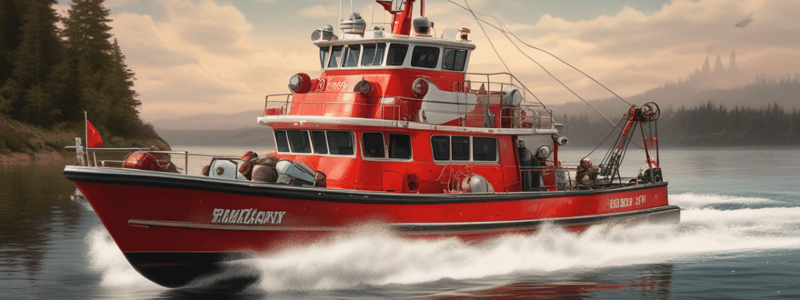Podcast
Questions and Answers
What is the first step in launching a watercraft at a launch site?
What is the first step in launching a watercraft at a launch site?
- Back the watercraft into the water.
- Disconnect the wiring harness from the tow vehicle.
- Load and store equipment needed for the operation.
- Don your PFD. (correct)
What should you do before shifting the engine into gear?
What should you do before shifting the engine into gear?
- Shift into neutral position.
- Reduce engine speed to idle. (correct)
- Attach the lanyard to the operator.
- Increase engine speed.
What is the purpose of squeezing the fuel line primer bulb?
What is the purpose of squeezing the fuel line primer bulb?
- To drain excess fuel from the engine.
- To mix air and fuel in the engine.
- To prime the fuel line and ensure proper fuel flow. (correct)
- To create a vacuum in the fuel line.
How long should you wait before trying to start the engine again if it fails to start?
How long should you wait before trying to start the engine again if it fails to start?
What should you check after starting the engine?
What should you check after starting the engine?
Why is it essential to allow the engine to warm up at idle speed for 3 minutes?
Why is it essential to allow the engine to warm up at idle speed for 3 minutes?
What should you do when stopping the watercraft?
What should you do when stopping the watercraft?
What is the purpose of the tilt lock lever?
What is the purpose of the tilt lock lever?
According to the guidelines, which of the following actions is NOT considered safe boat operation?
According to the guidelines, which of the following actions is NOT considered safe boat operation?
The 'Re-evaluation Date' of the Standard Operating Guidelines (SOG) for Boat Operations is:
The 'Re-evaluation Date' of the Standard Operating Guidelines (SOG) for Boat Operations is:
What is the primary objective of these Standard Operating Guidelines (SOG)?
What is the primary objective of these Standard Operating Guidelines (SOG)?
Which of the following is NOT a direct safety guideline for boat operations stated in the document?
Which of the following is NOT a direct safety guideline for boat operations stated in the document?
What is the significance of the phrase 'NIMS COMPLIANT' in the document?
What is the significance of the phrase 'NIMS COMPLIANT' in the document?
Based on the document, what is the primary factor driving the need for these SOGs?
Based on the document, what is the primary factor driving the need for these SOGs?
What can be inferred about the content of the document's 'attached towing, launching, motor operation and retrieval procedures'?
What can be inferred about the content of the document's 'attached towing, launching, motor operation and retrieval procedures'?
Why would the author mention that 'some special situations call for the use of the boat in higher risk levels'?
Why would the author mention that 'some special situations call for the use of the boat in higher risk levels'?
What action should be taken regarding the motor when the use of paddles is indicated?
What action should be taken regarding the motor when the use of paddles is indicated?
Which vehicle is not listed as an option for vehicle towing?
Which vehicle is not listed as an option for vehicle towing?
Which step is not part of the trailer attaching procedure?
Which step is not part of the trailer attaching procedure?
What should be checked during pre-launching in the parking area?
What should be checked during pre-launching in the parking area?
What is the appropriate action if a diver is in the water while the boat is at anchor?
What is the appropriate action if a diver is in the water while the boat is at anchor?
Which scenario allows the use of the electric trolling motor?
Which scenario allows the use of the electric trolling motor?
What must be inspected for tightness before launching the boat?
What must be inspected for tightness before launching the boat?
Who should perform the side scan sonar for target location and identification?
Who should perform the side scan sonar for target location and identification?
What is the first step to stop the engine according to the operating procedure?
What is the first step to stop the engine according to the operating procedure?
When selecting an anchoring area, which condition is least desirable?
When selecting an anchoring area, which condition is least desirable?
Before lowering the anchor, what is the recommended position for the boat?
Before lowering the anchor, what is the recommended position for the boat?
How much anchor line should be let out in relation to the water depth?
How much anchor line should be let out in relation to the water depth?
What is the correct procedure for retrieving the boat if it is not in the water?
What is the correct procedure for retrieving the boat if it is not in the water?
What should not be used when loading the boat onto the trailer?
What should not be used when loading the boat onto the trailer?
What is the last step to take while still at the ramp area after retrieving the boat?
What is the last step to take while still at the ramp area after retrieving the boat?
What is the purpose of taking visual sightings of onshore objects after anchoring?
What is the purpose of taking visual sightings of onshore objects after anchoring?
Flashcards are hidden until you start studying
Study Notes
Boat Operations Safety
- All personnel must wear proper floatation devices at all times in the boat, in the water, or on land within 10' of the water's edge.
- The boat operator must attach the engine stop lanyard to their person prior to starting the engine and when the boat is underway.
- The boat operator must not get underway until all equipment is secure and passengers are seated.
- Do not use a motor on a boat within 200' of a diver in the water; paddles must be used instead.
- When using paddles or anchoring with a diver in the water, the motor must be raised out of the water.
- Any boats operating at night must have proper lighting on board.
Trailering and Launching
- Trailers can be attached to vehicles Dive 24, Utility 22, or Car 8.
- Attach the trailer to the tow vehicle by raising the front of the trailer, backing the vehicle until the coupler is over the hitch ball, and locking the coupler into place.
- Ensure the trailer is locked on the tow ball by raising the front of the trailer slightly and checking the safety chains.
- Connect the trailer wiring harness to the tow vehicle and check trailer lights for proper operation.
Pre-Launching and Launching
- Pre-launching checks include ensuring drain plugs are in place, removing stern tie downs, and completing the pre-starting checklist.
- Launching involves backing the watercraft into the water, disconnecting the wiring harness, and setting the parking brake of the tow vehicle.
- Don your PFD before launching the boat.
Boat Motor Starting and Operating Procedures
- Pre-starting checks include checking fuel level, assuring fuel tank vent is open, and squeezing the fuel line primer bulb.
- Starting the motor involves releasing the tilt lock lever, lowering the motor into the water, squeezing the fuel primer bulb, setting the lanyard stop switch to "RUN" position, and pushing the starter button.
- Gear shifting involves allowing the engine to warm up, ensuring all equipment is secured, reducing engine speed to idle, shifting into desired gear, and advancing the throttle handle to increase speed.
Stopping and Anchoring
- Stopping the motor involves reducing engine speed to idle, shifting into neutral position, pushing the engine stop button, and removing the lanyard from the operator.
- Anchoring involves selecting a suitable area, heading into the wind or current, stopping the boat, and slowly lowering anchors over each side of the bow to the bottom.
- Ensure the anchor is set by backing the boat away and taking visual sightings of onshore objects or buoys in the water.
Retrieving the Boat
- Retrieving the boat involves backing the trailer into the water, attaching the winch line to the bow eye of the boat, and cranking the winch to pull the boat onto the trailer.
- Shut off the engine, raise the engine, pull the boat out of the water, and remove all weeds from the boat and trailer.
- Secure the boat on the trailer and attach the stern tie downs.
Studying That Suits You
Use AI to generate personalized quizzes and flashcards to suit your learning preferences.



